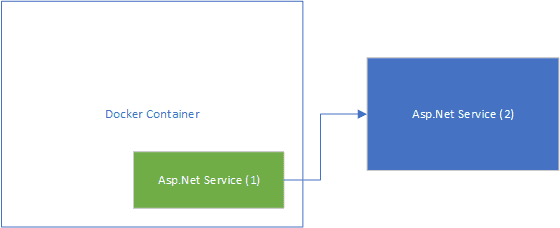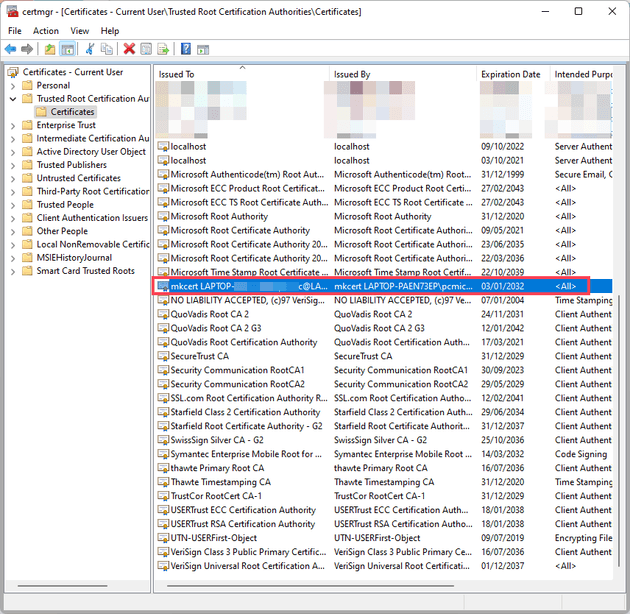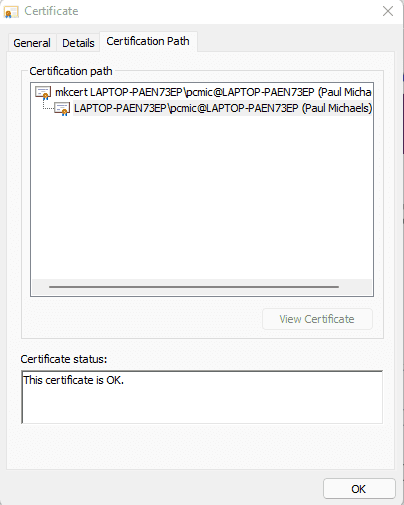I’ve recently being wrestling with trying to get an ASP.Net service within a docker container to call a service running outside of that container (but on the same machine). As you’ll see as we get further into the post, this is a lot more difficult that it first appears. Let’s start with a diagram to illustrate the problem:
The diagram above illustrates, at a very basic level, what I was trying to achieve. Essentially, have the service running inside docker call to a service outside of docker. In real life, the service (2) would be remote: very likely on a different physical server, and definitely have an allocated domain address; however, for this experiment, it lives on the same physical (or virtual) machine as the docker host.
Before I continue, I must point out that the solution to this comes by way of some amazing help by Rob Richardson: he gave a talk at NDC Porto that got be about 70% of the way there, and helped me out further to actually get this working!
Referencing a Service outside of Docker from within Docker
Firstly, let’s consider a traditional docker problem: if I load Asp.Net Service (2) then I would do so in a browser referencing localhost. However, if I reference localhost from within docker, that refers to the localhost of the container, not the host machine. The way around this is with host.docker.internal: this gives you a path to the host machine of the docker container.
Certificates - The Problem
Okay, so onto the next (and main) issue: when I try to call Asp.Net Service (2) from the docker container, I get an SSL error:
The remote certificate is invalid according to the validation procedure: RemoteCertificateNameMismatch, RemoteCertificateChainErrors
Why
The reason has to do with the way that certificates work; and, in some cases, don’t work. Firstly, if you watch the linked video, you’ll see that the dev-cert functionality in Linux has a slight flaw - in that it doesn’t do anything*. Secondly, because you’re jumping (effectively) across machines here, you can’t just issue a dev cert to each anyway, as it will be a different dev cert; and thirdly, dev-certs are issues to localhost by default: but as we saw, we’re actually trying to contact host.docker.internal.
Just to elaborate on the trust chain; let’s consider the following diagram:
In this diagram, Certificate A is based on the Root Certificate - if the machine trusts the root certificate, then it will trust Certificate A - however, the same machine will only trust Certificate B if it is explicitly told to do so.
This means that the dev cert for the container will not be trusted on the host, and vice-versa - as neither have any trust chain and relationship - this is the problem, but it’s also the solution.
Okay, so that’s the why - onto the how…
mkcert
Let’s start with introducing mkcert - this is an incredibly useful tool that hugely simplifies the whole process; it can be installed via chocolatey:
choco install mkcert
If you don’t want to use Chocolatey, then the repo is here.
Essentially, what this allows us to do is to create a trusted root certificate, from which, we can base our other certificates. So, once this is installed, we can create a new trusted root certificate like this:
mkcert -install
This installs our trusted root certificate; which we can see here:
This will also generate the following files (on Windows, these will be in %localappdata%\mkcert):
rootCA.pem
rootCA-key.pem
These are the root certificates, so the next thing we need is a certificate that covers the specific domain. You can do that by simply calling mkcert with the appropriate domain(s):
mkcert localhost host.docker.internal
This creates a valid cert for both localhost and host.docker.internal:
localhost.pem
localhost-key.pem
You may wish to rename these to be something slightly more descriptive, but for the purpose of this post, this is sufficient.
Docker
Almost there now - we have our certificates, but we need to copy them to the correct location. Because we’ve run mkcert -install the root certificate is already on the local machine; however, we now need that on the docker client (Asp.Net Service (1) from the diagram above). Firstly, let’s download a mkcert.exe from here for the relevant version of Linux that you’re running.
Let’s copy both the rootCA.pem and rootCA-key.pem into our Asp.Net Service (1) project and then change the dockerfile:
. . .
FROM base AS final
WORKDIR /app
COPY mkcert /usr/local/bin
COPY rootCA\*.pem /root/.local/share/mkcert/
RUN chmod +x /usr/local/bin/mkcert \\
&& mkcert -install \\
&& rm -rf /usr/local/bin/mkcert
COPY --from=publish /app/publish .
. . .
A few things to mention here:
- The rest of this file is from the standard Ast.Net docker file. See this post for possible modifications to that file.
- Each time you execute a RUN command docker makes a temporary image, hence why combining three lines (on line 7) with the && makes sense.
- When you run the mkcert -install it will pick up the root certificate that you copy into the /root/.local/share/mkcert.
- Make sure that these lines apply to the runtime version of the image, and not the SDK version (there’s absolutely no point in adding a certificate to the SDK version).
- The last line (rm -rf /usr/local/bin/mkcert) just cleans up the mkcert files.
The Service
The final part is to copy the generated certificates (localhost.pem and localhost-key.pem) over to the service application (Asp.Net Service (2)). Finally, in the appsettings.json, we need to tell Kestrel to use that key:
{
"Logging": {
"LogLevel": {
"Default": "Information",
"Microsoft.AspNetCore": "Warning"
}
},
"AllowedHosts": "\*",
"Kestrel": {
"Certificates": {
"Default": {
"Path": "localhost-host.pem",
"KeyPath": "localhost-host-key.pem"
}
}
}
}
That’s it! If you open up the Asp.Net Service (2), you can check the certificate, and see that it’s based on the mkcert root:
References and Acknowledgements
As I said at the start, this video and Rob himself helped me a lot with this - so thanks to him!
It’s also worth mentioning that without mkcert this process would be considerably more difficult!
Footnotes
* actually, that’s not strictly true - Rob points out in his video the nuance here; but the takeaway is that it’s unlikely to be helpful



